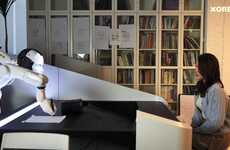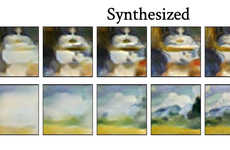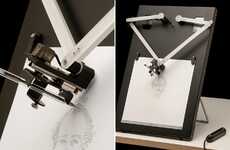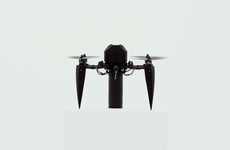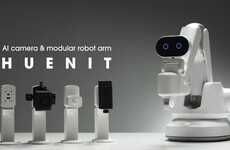
This Painting Robot Can Create Works of Art
Rahul Kalvapalle — October 1, 2015 — Tech
References: www3.imperial.ac.uk & gizmag
A group of scientists has managed to develop a fascinating painting robot that uses a special robotic arm to paint. This robot is fitted with a new high-tech arm that can grasp onto a painting brush and use it to put together a multi-colored oil painting.
Now one may argue that painting robots are no fun at all because there's really no replacing a human being who can convert his visions into paintings on canvas, but that's not really the point here. This particular robot demonstrates just how fluid, versatile and creative robotic limbs can be. The idea is that this particular technology could one day be used in other applications and could be used in medical, manufacturing or even entertainment-centric environments.
Now one may argue that painting robots are no fun at all because there's really no replacing a human being who can convert his visions into paintings on canvas, but that's not really the point here. This particular robot demonstrates just how fluid, versatile and creative robotic limbs can be. The idea is that this particular technology could one day be used in other applications and could be used in medical, manufacturing or even entertainment-centric environments.
Trend Themes
1. Versatile Robotic Arms - The development of painting robots with high-tech arms that can grasp painting brushes and use them to create multi-colored oil paintings demonstrates the fluid, versatile and creative potential for robotic limbs in medical, manufacturing or even entertainment-centric environments.
2. Robotic Artistry - The emergence of painting robots challenges the notion that only humans can convert their visions into art, thereby disrupting the traditional artistic landscape and pushing the boundaries of what is possible with technological advancements in the field.
3. Automated Manufacturing - The use of robotic arms in painting not only demonstrates the creative potential of this technology, but also its potential to automate manufacturing processes, allowing for more efficient and precise production in a variety of industries.
Industry Implications
1. Artificial Intelligence - The development of painting robots demonstrates the potential for AI to revolutionize the art world and offer new creative opportunities not thought possible before.
2. Manufacturing - The use of robotic arms for painting not only expands creative possibilities, but also disrupts traditional manufacturing processes and offers more efficient, precise and cost-effective production methods.
3. Medical Technology - The fluid, versatile and creative potential for robotic limbs demonstrated by the development of painting robots could have significant applications in medical technology, such as prosthetic limbs and surgical tools with increased dexterity and precision.
1.3
Score
Popularity
Activity
Freshness



